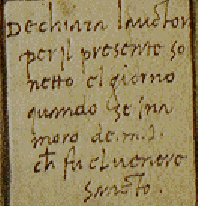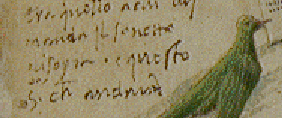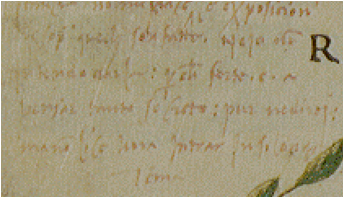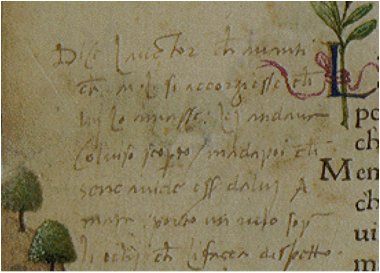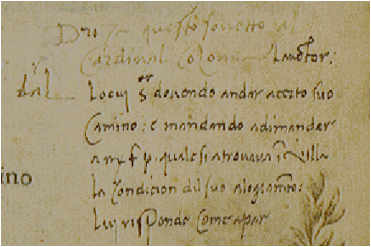Punctuation
As for the use of punctuation signs, it is very instructive to confront the Queriniana copy of the editio princeps with the copies from the Marciana library in Venice or Trivulziana library in Milan to see that, except for the very rare use of the punctus, all the other punctuation in the Queriniana copy has been added by handwriting to the printed poems. All of this confirms that one of the driving motivations behind the orthographic and linguistic rationalization realized by the Quattrocento typographers was the need to save paper, ink, and characters (Trovato 9). The punctuation added to the original document has not been transcribed in the OPOB edition. On the other hand, all the punctuation present in the handwritten glosses has been transcribed as it appears in the document without modernizing any feature or adding modern punctuation signs. Giuseppe Frasso published a complete transcription of the handwritten glosses with the insertion of modern punctuation ("Antonio Grifo postillatore dell'incunabolo Queriniano G V 15" 89-137).
The basic punctuation signs used by Grifo in the handwritten glosses are the punctus and the colon. The punctus that can be a terminal punctus (fig. 1) to indicate what we use nowadays as period. See here one example from gloss to poem 3:
Figure 1 (13)Grifo does not write the terminal punctus at the end of the all the glosses; in certain cases the punctus is not readable. In this cases the transcription does not supply the punctus. Grifo also uses a special case of punctus, when it is used in the manuscript not to indicate a period but a different kind of intermediate pause. We identify this type of punctuation sign as “medial punctus” and encode it in this way: <pc type="medial_punctus"></pc>. In certain cases it can indicate a virgula (fig.2). See here one example from the gloss to poem 28:
Figure 2 (10v)Another use of the “medial” punctus is to indicate the accent on the letter “e”. In this case the Grifo writes one “medial” punctus before the letter “e” and one after, as in the following example taken from the gloss to poem 24, see the first line (fig. 3):
Figure 3 (9v)Widespread in the glosses is the use of the colon for what we use nowadays as comma. See for instance this use of the colon after the word “di fuori” (line 2) and “Amico” (line 3) in the gloss to poem 9 (fig.4):
Figure 4 (3r)In reality, from a modern perspective the colon may indicate different punctuation sign, including the modern colon itself and the semicolon. The transcription published in the OPOB edition does not modernize the colon in any instance. Here is an example of colon used as the actual semicolon in the gloss to poem 70 after the word “secreto” in the fourth line reproduced in this image (fig. 5):
Figure 5 (28v)The punctus interrogativus is not used by Grifo in the handwritten glosses. He uses it in the handwritten additions he made to the printed poems, which we did not transcribe.
Another punctuation sign used by Grifo is a small slash used to indicate mostly the virgula. See for example the fourth line of gloss to poem 11 (fig. 6).
Figure 6 (3v)We transcribed and encoded one case of multiple expunctuation signs from the gloss to poem 70. The expunctuation signs erase the words “in questa canzone”:
Figure 7 (28v)We encoded Grifo’s use of two inks in the glosses that has been already pointed out by Frasso (86-88). One ink is light brown and the other light red. Also, we encoded the use of darker ink to add new lines to an already written gloss or to highlight words that were difficult to read in an original earlier written gloss. See one example here from the gloss to poem 10:
Figure 8 (3r)Moreover, we encoded the lines break as they appear on the pages.
Finally, we encoded the cases of unreadable handwriting as <unclear>. See for instance the code for the first two lines of gloss to poem 325:
<lb/> Come sa chi uol dir<pc type="colon"></pc>e dubita de<choice><abbr>nō</abbr> <expan>non</expan></choice>nocer<lb />a chi tocchi <pc type="colon"></pc> <choice><abbr>o<unclear></unclear></abbr><expan>ouer </expan></choice> alo ascoltante dice<choice><abbr type="elision">lauctor</abbr><expan>l'auctor</expan> </choice>
Figure 9 (115r)